News Letter
Sign Up & get 33% off your first order
Enter your preferred name & e-mail to subscribe

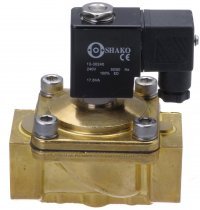
Brass, Stainless Steel or Plastic Water solenoid valves would all be described as for general purpose applications as all three materials are suitable for mains water use, but attention needs to be given to the water application parameters.
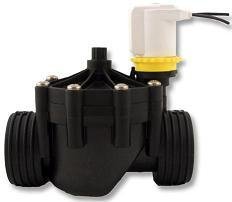
It is good practice to check the flow required for the application and check this against the CV or Kv flow coefficient of the solenoid valve to be used. If the valve is too small, the system will starve of water and the water may well travel excessively fast to achieve the desired flow, potentially causing water hammer in the pipework. The other way around can be that the solenoid valve is too big for the required application, which not only increases cost but can when using a pressure assisted solenoid valve (also known as servo assisted solenoid valve) cause a very annoying chattering noise when energised open (allowing flow). This is caused by the fact that a pressure assisted solenoid valve requires a pressure differential to open or close, but when the solenoid valve is open it allows flow faster than the system demand and which generates a back pressure cancelling the pressure differential thus closing the solenoid valve. The instant the solenoid valve is forced closed by the back pressure, a pressure difference is generated as demand now exceeds supply which allows the solenoid valve to open again, and this cycle repeats until the solenoid valve is switched off or the demand for water stops.
Typical water solenoid valves will have NBR seals that are rated between 60 and 80°C, whereas EPDM can typically withstand temperatures up to 150°C. If higher temperatures are required, it is wise to use the correct steam rated solenoid valve, which should have PTFE seals and an H or N rated high temperature coil designed to resist the heat of the application.
Solenoid valves are ideal for the ON/OFF flow control of water, but water will carry varying amounts of deposits including minerals, particles are calcium. As you know if you look inside your kettle, dishwasher or washing machine, central heating system you will find lime-scale, a hard off-white chalky deposit that is typically Calcium. A solenoid valve when energised produces heat, and if energised for typically more than 20 minutes will reach its maximum temperature, which can be anywhere up to 120 degrees centigrade. The electrical energy is used to generate a magnetic field to operate the solenoid valve, but even a 10-watt coil will generate heat. This heat builds and can only disperse through the ambient environment, the metal pipe and the media flowing through it. However, the coil or heat source is typically fitted onto the core tube, which is in itself a dead end and will see very limited flow.
In hard water areas over time this will cause a solenoid valve armature to fill with lime scale deposits, and finally it will stick and fail. This is usually followed by the solenoid coil burning out especially if it is 50/60Hz AC coil, as it will stay in what we call the inrush state i.e. trying to move or lift the armature, and because the armature will not move the coil will over heat. Typically engineers replace the coil and then complain as this also failed within hours.
There are 2 solutions to this problem, the easy solution is to fit a valve that will not suffer from lime-scale, but lime scale will still build up in the system over time and cause blockages and issues in the remaining system at some point in time. The intelligent solution is to fit a water softener, this will remove the lime-scale from the water, allowing the solenoid valves, pipework and other process systems to run cleanly and effectively well into the future.
Typical water applications are well suited for Brass or even Plastic solenoid valves, but if food or chemical processing systems either the system or the environment are cleaned using corrosive antibacterial chemicals which can make Brass or plastic solenoid valves unsuitable, so stainless steel solenoid valves need to be used. In some instances in processing of animal feed, sugar or flour for example there can be a build up of potentially explosive dusts in the atmosphere. In these instances the area will have a hazardous area rating and a solenoid valve with ATEX hazardous area certification will be required, either EEx m II T4 or EEx d II C T6 for example.
Whether it is a plastic, brass or stainless steel solenoid valve there are typically two different solenoid valve methods of operation, see below.
 Assisted lift, direct acting or hung diaphragm solenoid valves do not require a pressure differential to operate i.e. a
Assisted lift, direct acting or hung diaphragm solenoid valves do not require a pressure differential to operate i.e. a 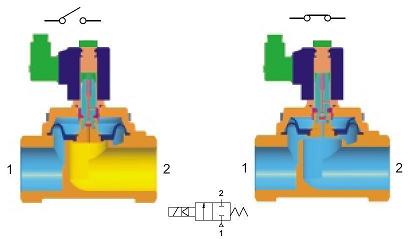 pressure difference between the inlet and outlet ports and are ideally suited for most mains water applications, offering high flow rates. No consideration needs to be given to pressure differential, and engineers can fit these solenoid valves in the safe knowledge of a positive opening and closing function regardless of system pressures. These are ideal for low pressure, vacuum, gravity fed and closed loop systems, however typically they can operate up to 10 bar or more.
pressure difference between the inlet and outlet ports and are ideally suited for most mains water applications, offering high flow rates. No consideration needs to be given to pressure differential, and engineers can fit these solenoid valves in the safe knowledge of a positive opening and closing function regardless of system pressures. These are ideal for low pressure, vacuum, gravity fed and closed loop systems, however typically they can operate up to 10 bar or more.
Helpful hint: Coil typically mounted centrally.
Typical pressure ranges: 0 to 10 Bar
Typical sizes ranges : 3/8 to 2" thread and flange DN10 to DN300
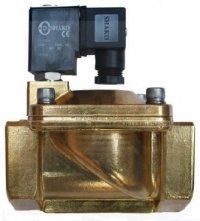 Pressure assisted or floating diaphragm solenoid valves for water require a pressure difference between the inlet
Pressure assisted or floating diaphragm solenoid valves for water require a pressure difference between the inlet 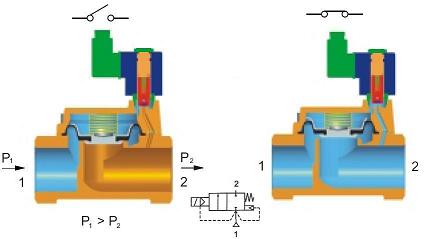 and outlet ports to open and close. These are ideal for most mains water supply because they provide a high flow rate and typically mains water will supply sufficient pressure differentials for operation. These are ideal for open to atmosphere tank refill systems and systems that will offer the required pressure differential. Another benefit is that this design of water solenoid valve is typically less expensive than as assisted lift deign.
and outlet ports to open and close. These are ideal for most mains water supply because they provide a high flow rate and typically mains water will supply sufficient pressure differentials for operation. These are ideal for open to atmosphere tank refill systems and systems that will offer the required pressure differential. Another benefit is that this design of water solenoid valve is typically less expensive than as assisted lift deign.
Helpful hint: Coil typically mounted over outlet port.
Typical pressure ranges: 0.5 to 10 Bar
Typical sizes ranges : 3/8 to 3" thread and flange DN10 to DN 500
Water solenoid valves are typically 12vDC, 24vDC, 24vAC or 230vAC, although other voltages such as 12vAC, 110vAC or 380vAC are also found for these applications but are not so common. 12 and 24 volt solenoid valves are referred to as low voltage valves and are the preferred choice for most installers as these are deemed safe. High voltage 110 and 230volt valves can also be used if the earth connection at the DIN connector is used in conjunction with a quality CE certified IP65 protected and 100% duty cycle Shako solenoid.
Remember you can view a full range of WRAS approved valves online at solenoid-valve.world
A catalouge of articles covering all aspects of solenoid valves
Enter your preferred name & e-mail to subscribe